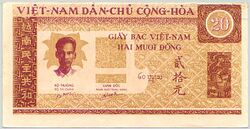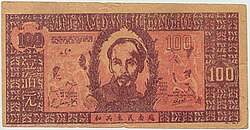Finance:North Vietnamese đồng
| đồng Việt Nam Dân Chủ Cộng Hòa (Vietnamese) | |||||
|---|---|---|---|---|---|
| |||||
| Unit | |||||
| Symbol | ₫ | ||||
| Denominations | |||||
| Subunit | |||||
| 1⁄10 | hào | ||||
| 1⁄100 | xu | ||||
| Banknotes | 2, 5 xu, 1, 2, 5 hào, 1, 2, 5, 10 đồng | ||||
| Coins | 1, 2, 5 xu | ||||
| Demographics | |||||
| User(s) | |||||
| Issuance | |||||
| Central bank | National Bank of Vietnam and State Bank of Vietnam | ||||
| Website | www | ||||
| This infobox shows the latest status before this currency was rendered obsolete. | |||||
The đồng (Chữ Nôm: 銅; Chữ Hán: 元, nguyên)[lower-alpha 1] (/ˈdɒŋ/; Vietnamese: [ɗôŋm]) was the currency of North Vietnam from 3 November 1946 to 2 May 1978. It was subdivided into 10 hào, each itself divided into 10 xu.
History
The first đồng issued by the communists controlling northern Vietnam was introduced on January 31, 1946, and replaced the French Indochinese piastre at par. Two revaluations followed. In 1951, the second đồng was introduced at a rate of 1 1951 đồng = 100 1946 đồng. However, some sources say there were two consecutive revaluations in 1951 and 1953, each with factor of 10. In 1954, this became the currency of the newly recognized state of North Vietnam, with an exchange rate to the still circulating piastre and South Vietnamese đồng of 32 northern đồng = 1 piastre or southern đồng. In 1956, the đồng was pegged to the Chinese renminbi yuan at a rate of 1.47 đồng = 1 yuan.
On 28 February 1959, another đồng replaced the second at a rate of 1 1959 đồng = 1000 1951 đồng. An exchange rate with the Soviet rouble was established in 1961, with 3.27 đồng = 1 rouble. On May 3, 1978, following the unification of Vietnam, the đồng was also unified. 1 new đồng = 1 northern đồng = 0.8 southern "liberation" đồng.
Coins
1946 đồng
In 1946, aluminium 20 xu, 5 hào and 1 đồng and bronze 2 đồng were issued, with the 20 xu coins dated 1945. These were the only coins issued for this currency, with no coins at all issued for the 1951 đồng.
| Coins of the North Vietnamese đồng – 1946 issue | |||||||||||||
|---|---|---|---|---|---|---|---|---|---|---|---|---|---|
| Obverse | Reverse | Denomination | Composition | Obverse | Reverse | ||||||||
| 20 xu | aluminium | Star | Denomination | ||||||||||
| 5 hào | aluminium | Ceremonial urn | Denomination | ||||||||||
| 5 hào | aluminium | Ceremonial urn | Denomination | ||||||||||
| 1 đồng | aluminium | Hồ Chí Minh | Denomination | ||||||||||
| 2 đồng | bronze | Hồ Chí Minh | Star; denomination | ||||||||||
1958 đồng
In 1958, holed, aluminium coins in denominations of 1, 2 and 5 xu were introduced. These were the only coins issued in this currency.
| Coins of the North Vietnamese đồng – 1958 issue | |||||||||||||
|---|---|---|---|---|---|---|---|---|---|---|---|---|---|
| Obverse | Reverse | Denomination | Composition | Obverse | Reverse | ||||||||
| 1 xu | Aluminium | An emblem similar in design to the coat of arms of North Vietnam; Nước Việt Nam Dân Chú Cộng Hòa | Ngân Hàng Quốc Gia Việt Nam; denomination; date | ||||||||||
| 2 xu | Aluminium | emblem similar in design to the coat of arms of North Vietnam; Nước Việt Nam Dân Chú Cộng Hòa | Ngân Hàng Quốc Gia Việt Nam; denomination; date | ||||||||||
| 5 xu | Aluminium | emblem similar in design to the coat of arms of North Vietnam; Nước Việt Nam Dân Chú Cộng Hòa | Ngân Hàng Quốc Gia Việt Nam; denomination; date | ||||||||||
Banknotes
1946 đồng
The government (Việt Nam Dân Chủ Cộng Hòa) issued two forms of paper money for this currency, "Vietnamese banknotes" (Giấy Bạc Việt Nam) and "Credit notes" (Tín Phiếu). In 1946, banknotes were introduced in denominations of 20 and 50 xu, 1, 5, 20, 50, 100 đồng, together with credit notes for 1 đồng. These were followed in 1948 by banknotes for 10 đồng and credit notes for 20 đồng, in 1949 by 500 đồng banknotes and 5 and 50 đồng credit notes, and in 1950 by 200 đồng banknotes and 100, 500 and 1000 đồng credit notes.
1951 đồng
In 1951, the National Bank of Vietnam (Ngân hàng quốc gia Việt Nam) introduced notes for 20, 50, 100, 200, 500 and 1000 đồng, with 5000 đồng notes added in 1953. These were the only circulating currency between 1951 and 1958.
1959 đồng
In 1958, the National Bank introduced notes for 1 xu, 1, 2 and 5 hào, 1, 2, 5 and 10 đồng, with the 1 xu notes an overprint on an earlier, unissued type of 10 đồng note. In 1964, the State Bank of Vietnam (Ngân hàng Nhà nước Việt Nam) introduced 2 xu notes, followed by 5 xu, 1 and 2 hào in 1975.
See also
- South Vietnamese đồng
- Economy of Vietnam
Gallery
Notes
- ↑ Chữ Hán appeared on North Vietnamese banknotes that were issued until 1953. The term nguyên (元) was used for the Hán inscriptions, while đồng (銅) was used in Latin script as the name for the currency. Also note that in Chinese languages the đồng is called the "北越盾" (Bắc Việt thuẫn, "Northern Việt shield"), because of the similarity in pronunciation between the Vietnamese "銅" and Chinese "盾".
References
- Howard A. Daniel, III (1995) Democratic Republic of Vietnam Coins and Currency. ISBN:1-879951-03-7[self-published source]
External links
 |
















